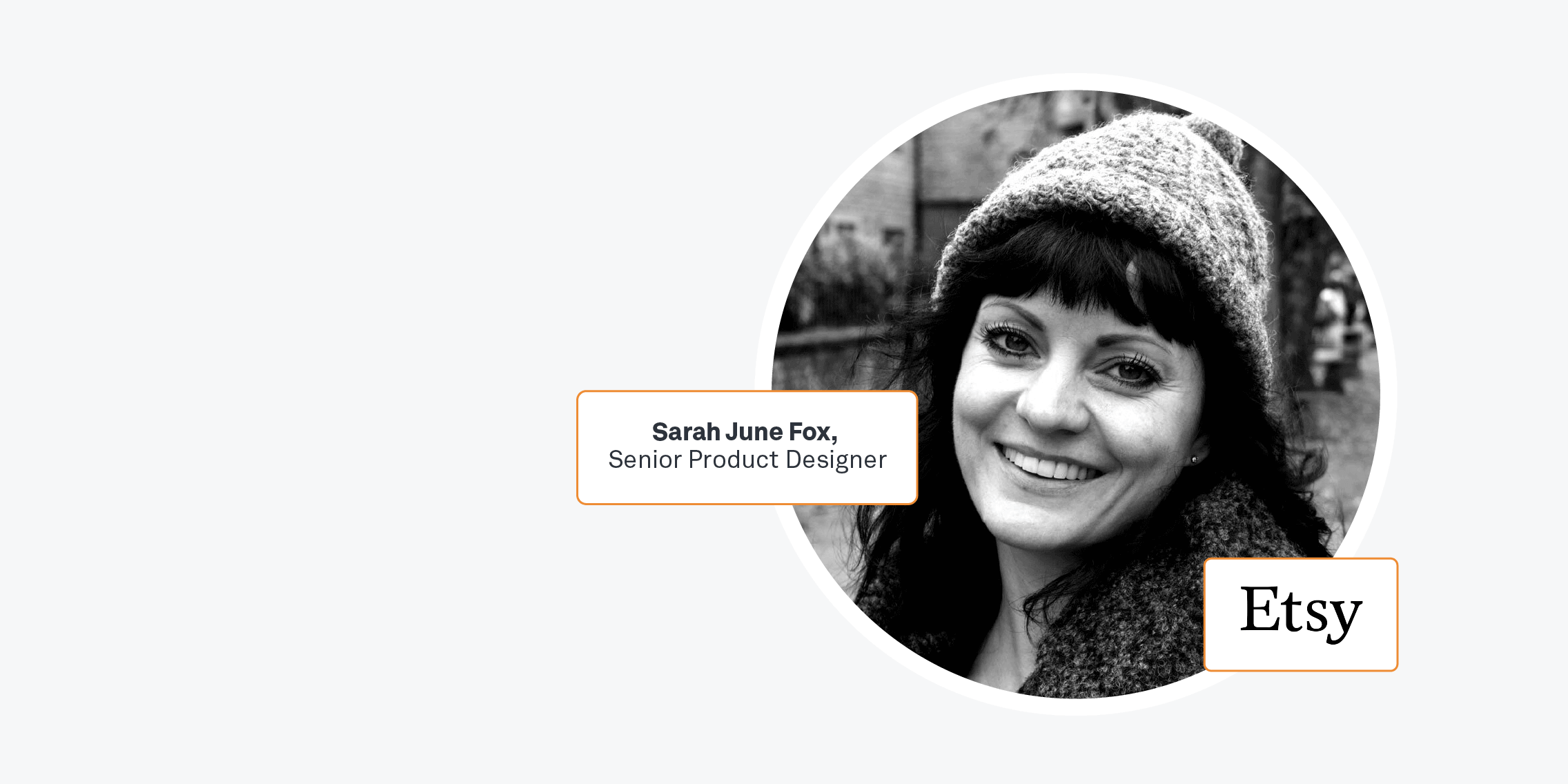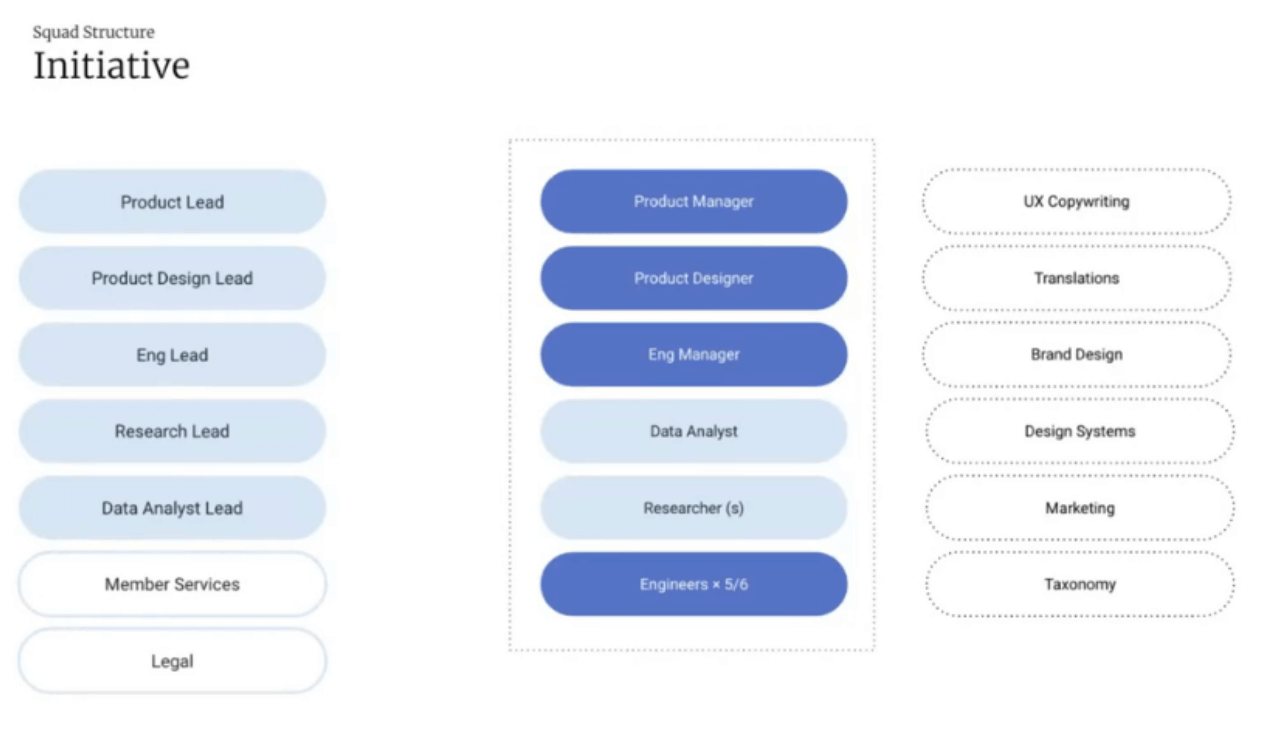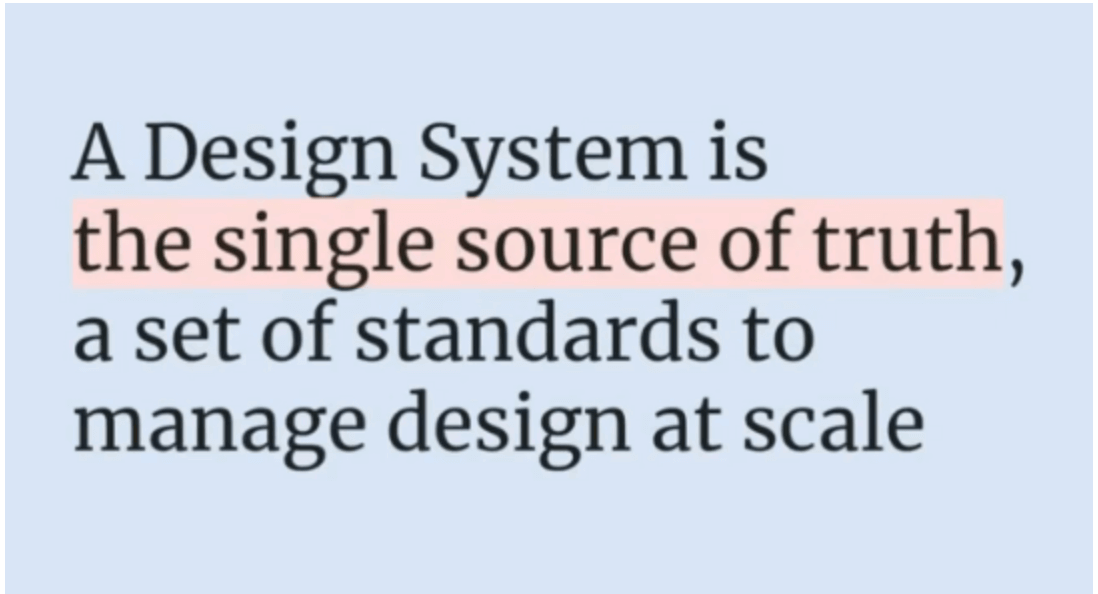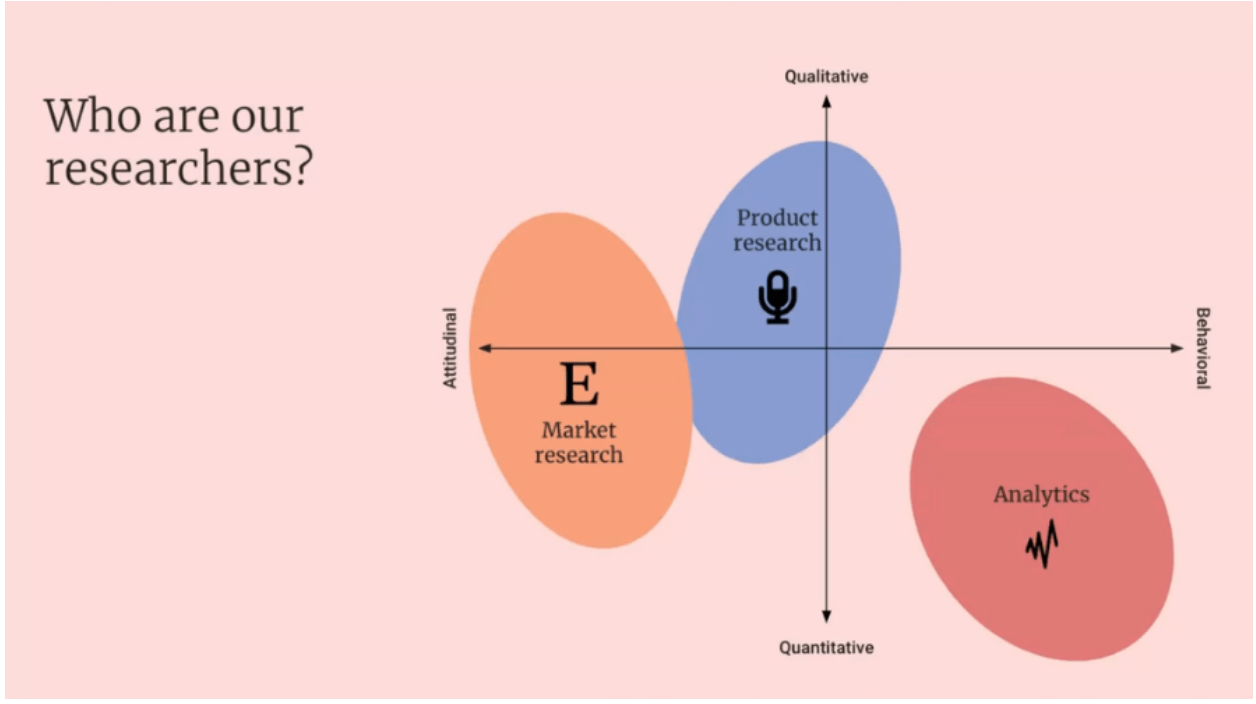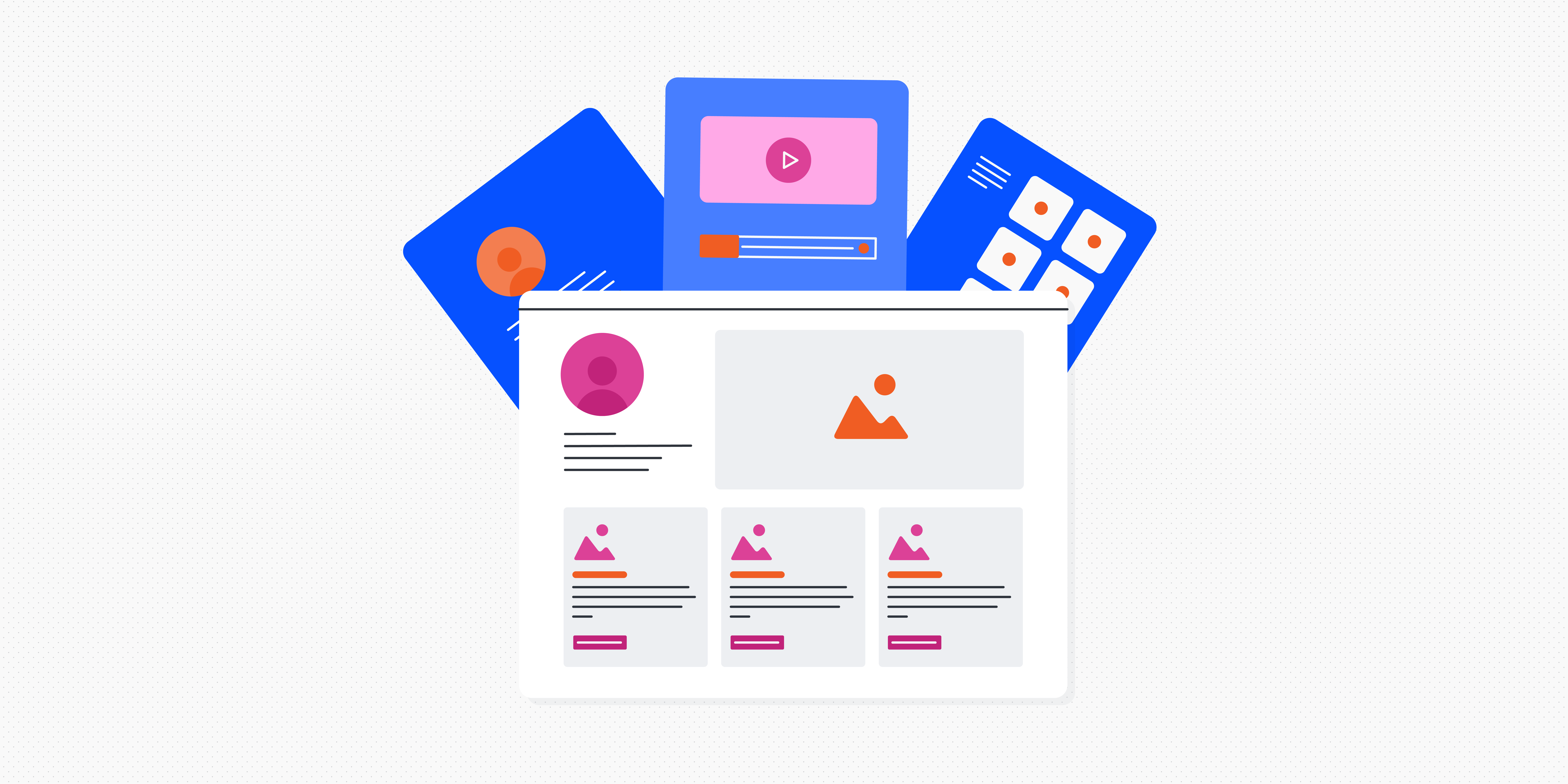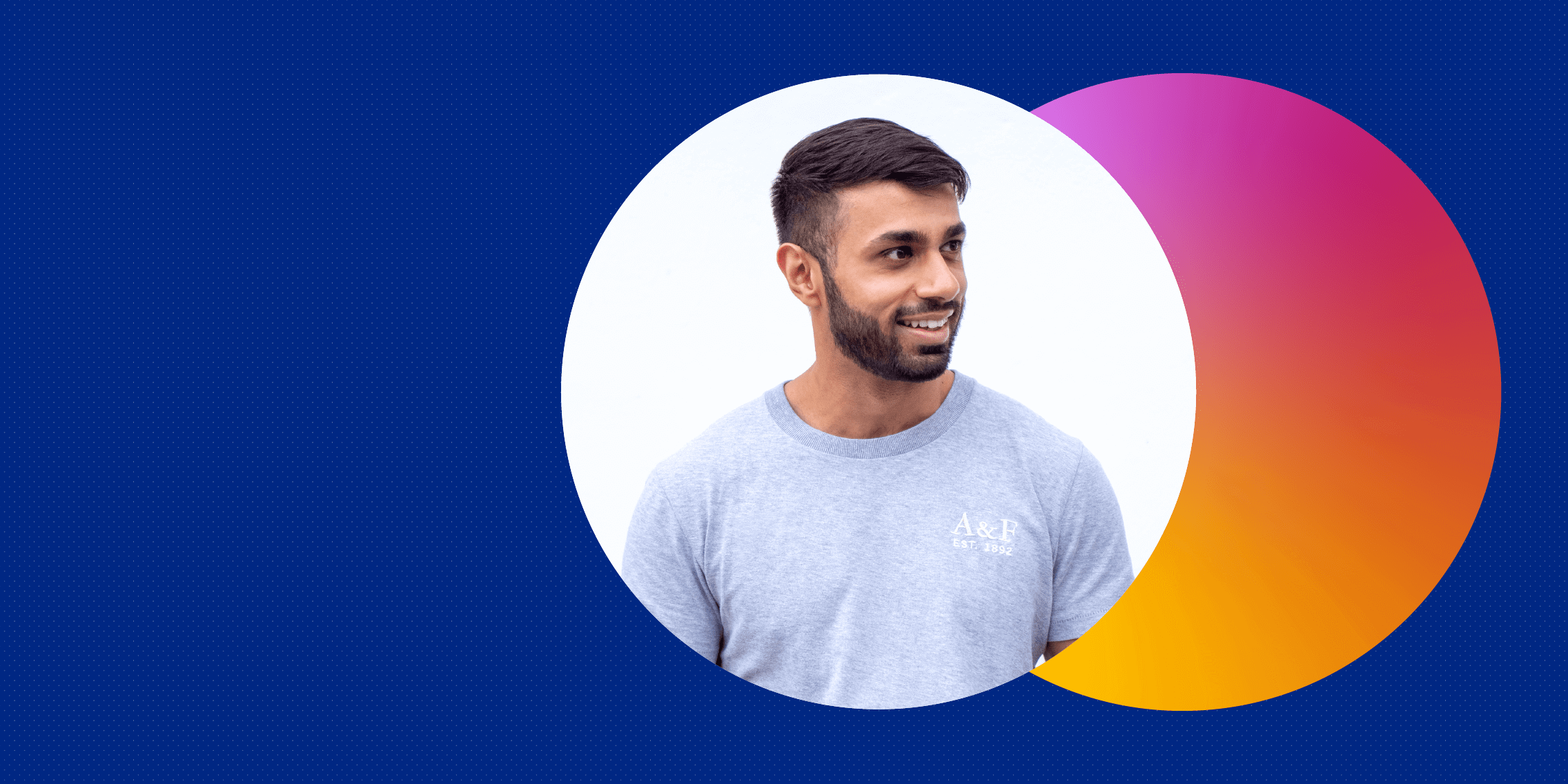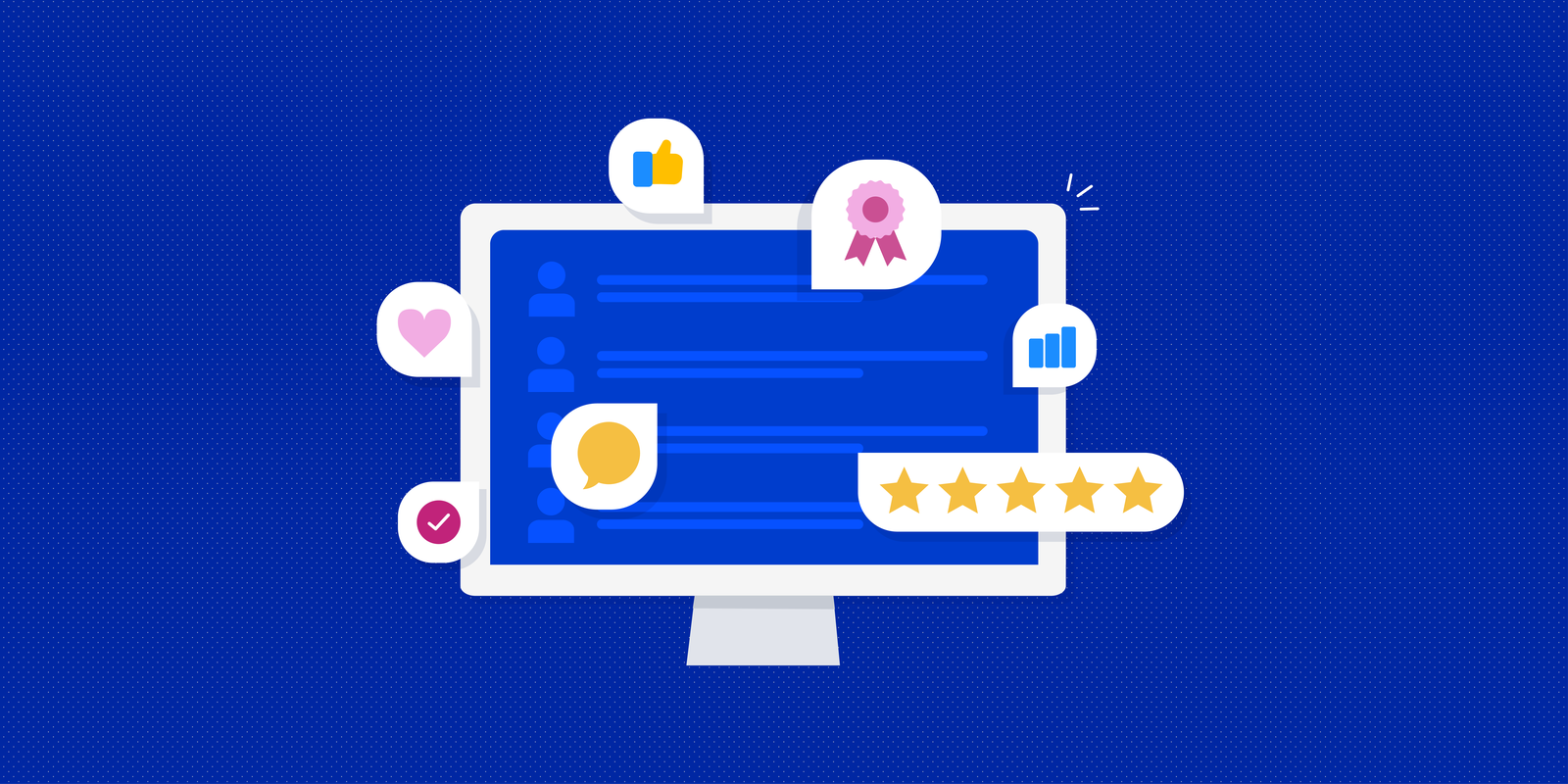Sarah June Fox is a Senior Product Designer at Etsy. She works on the International, New Markets initiative as a Design Operationss: Core Practices co-lead, bringing Etsy’s products to markets outside the U.S.
Sarah June is also a member of the steering committee for the 100Archive and an inductee to the International Society of Typographic Designers. Sarah June is also a regular speaker at Triangirls meet-ups and a Hexagon mentor.
We were fortunate enough to have her as a guest during our recent UX Insider event, which you can watch in full here or keep reading below for highlights from our conversation.
Sarah June joined us to the discuss benefits of design operations and investing in core design processes, including:
- Codified design practices
- Product design squads
- Cross-functional working relationships
- Etsy’s newly minted Core Design Practices Playbook
- What Etsy looks for in junior designers
Can you tell us a bit about Etsy and your role at the company?
I’ve been a product designer at Etsy for just over two years.
We’re a two-sided marketplace, meaning we have two equally important user groups: our buyers and our sellers. Our whole product suite needs to support all of their missions.
I’m a product designer in a large product design team. There are about 85 of us at the moment.
I’m working across two squads. One’s called New Markets and one’s called Core Localisation.
At a very high level, what we do is think about making improvements to our products that make Etsy feel like it’s local to places outside of the U.S. Etsy started in the U.S. and is very U.S.-centric, but what happens when somebody’s visiting from Japan or India?
We think about things like meeting local expectations of e-commerce and improving search results for non-English search queries. We think about taxonomy, language, local cultural norms, and pricing structures, among loads of other things.
Our vision is that the entire experience on Etsy feels like it’s created for every buyer and every seller, no matter their language or region.
Tell us about Etsy’s design team
Etsy started in 2005. Inspired by this “making” culture at the time, the design team was one person. Since then, the company grew organically, and what had formerly been just a handful of designers is now a multidisciplinary group of:
- product designers
- brand designers
- art directors
- CX strategists
- information architects
- copywriters
- researchers
There was a time when Etsy took a good look at the brand and the products, and then really looked at our internal processes and made huge strides to improve all of that by implementing a design organisation.
Why is it important to invest in design organisation?
I just want to say—I will be praising Etsy a lot and I think it’s because I’ve worked in less-structured places or less-happy atmospheres and Etsy just does so much right.
I’ve worked in companies that didn’t invest as much time into their own design org, and the experience wasn’t as positive as a result.
So the best part for me about Etsy is the collaborative creative element. There are no lone-wolf designers. There’s no hard handover to engineering. We work together on everything and our cross-functional partnerships are really strong as a result.
Having the support of dedicated experts like researchers or UX copywriters, for example, means that we as product designers have more time to concentrate on our own area of expertise.
And the investment into these design operations means that we’re not starting anything from scratch, even if we’re embedded alone on a squad. The designers work together as an org with things like weekly critique sessions, cross-initiative workshops, design showcases, and mentor relationships.
It’s a really good system.
How are Etsy’s squads structured?
Here’s a snapshot of our squad structure:
The group in the box above is an example of a single squad. We have a product designer (me), a product manager, an engineering manager, a data analyst, and a researcher that are shared across a few squads and then 5-6 dedicated engineers.
The product designers, product managers, and engineering managers are considered the thought leaders of the squad. And then everybody else you see is supporting us.
We get to work with people from legal, member services (which is like our customer service), research engineering, and then leaders from our group as well. So you’re never lost on your own.
The structure is organized to encourage this amazing collaboration and then utilize the strength of cognitive diversity. Everybody is an expert at something.
The value gained from getting other people to think like designers and encouraging creativity means that we’re removing the lens that suggests that designers are the only people who are allowed to create.
Are Etsy’s product designers working in UX, UI, or both?
Most of our product designers do a bit of everything. Some squads have greater UX needs while others will be more focused on UI.
If you think about somebody working on the app, for example, they would have a strong UI focus.
But I worked in a squad that was looking at tax compliance. This team was UX focused, thinking about how somebody uploads documents, for example. It mattered less what the pixels looked like.
How do you collaborate with engineers and ensure designs are produced the way you’re expecting?
If you do a waterfall handover, where designs are just passed on to engineers, there might’ve been a load of things you missed.
You can’t account for every scenario. Either the engineer has to make decisions on the fly or they have to hand it back to you.
The best collaborative experience for a handover is to involve engineers from the very beginning. If you can have your engineers in your discovery process, they will surface a lot of things you might not have thought about.
We have weekly check-ins where we discuss everything in the project, and then daily standups as well. Nothing goes for very long without a conversation about it.
What is Etsy’s design philosophy?
Our mission is to keep commerce human, and it’s really at the heart of everything that we do.
Everything now is automated. We want to keep the human connection at the heart of commerce. This is why we build a place where creativity is at the heart of everything that we do.
We help our community of sellers turn their ideas into successful businesses, and our platform connects them with millions of buyers looking for an alternative to the regular e-commerce landscape—something that’s special with a human touch.
To do this, we strive to lead with a set of guiding principles.
What are Etsy’s design principles?
Etsy’s design principles keep us on mission. They help spread ideas of sustainability and our responsibility for our impact on the world. Etsy treats its customers so well, and our outward-facing attitude is very transparent and human.
But importantly, it’s also how Etsy treats its employees. The culture is so supportive, nurturing, and highly collaborative. So we have this massive mission, but it’s accomplished in small steps.
Each change that we make to the website or our apps helps us build towards that goal. But how do we know if we are building in the right direction?
These are Etsy’s design principles:
- We embrace differences: Diverse teams are stronger, and inclusive cultures are more resilient. When we seek out different perspectives, we make better decisions and build better products.
- We lead with optimism: We believe in our mission, and we believe in each other. We see the world as it is, set ambitious goals, and inspire one another with generosity of spirit. Together, we reimagine what is possible.
- We minimise waste: Time, resources, and energy are precious, so we focus only on what will have the greatest impact.
- We dig deeper: The best solutions to meaningful challenges are rarely easy or obvious. We stay curious, balance our intuition with insights, and decide with confidence.
- We commit to our craft: Our work has the power to change lives. That’s why we strive to learn continuously and excel at what we do.
What is Etsy’s design process?
Etsy’s design process is rooted in design thinking. Etsy doesn’t ever want to be prescriptive, but we encourage what we call “choose your own adventure.”
Designers are empowered to work as they see fit and then to continue to challenge and evolve their methods as well.
There is no one-size-fits-all, but with a systematic approach, we’ll always have the best results in the problem spaces that we work in.
The product design process adjusts to fit the individual project, not the other way around.
For early-stage projects, we might spend more time doing user research. Whereas if something is already in production, we might be doing A/B experiments or multivariate tests, where continual improvement is really at the heart of what we do.
Nothing is sacred, nothing stays the same, and we continue to get feedback and refine as our user’s needs change over time as well.
How does Etsy make use of data in its design practices?
Etsy is very much a data-driven company. We want to use data to inform everything that we do.
We place a big emphasis on building with science—designing experiments that help us figure out how to improve our performance.
We analyze behavioral patterns over time, and this data helps us make improvements to the marketplace.
We write experiments, A/B tests, and multivariate tests. They help us validate our own assumptions and help us identify dead ends sooner, rather than spending, for example, three months building a feature that nobody ends up using.
We can run an experiment early in the process to understand whether we’re on the right path, and this helps us reduce risk and be more confident in the changes that we’re making.
What are the benefits of a design system?
We use a suite of design systems that help us with this idea of minimizing waste.
We have one for our apps, one for desktop and mobile web, and then one for our internal tooling as well.
These are well-implemented systems with brilliant documentation. These reusable components allow us to concentrate on UX and what’s happening in the flow without worrying about the radius of a button or which typeface to use.
These design systems:
- Promote consistency
- Reduce building time
- Get everyone on the same page
- Reduce design and development debt
- Allow room for innovation
- Contribute to strong, memorable brands
We have an entire Design Systems team responsible for creating our design systems.
It works like all our product squads work. It has a product manager, loads of engineers, engineering managers, researchers, and data analysts, and their whole job is to maintain and expand the design system.
Who are Etsy’s researchers?
Here’s an overview of the researchers our squad collaborates with:
Our product researchers answer more qualitative, “how’s it going?” questions, such as:
- What are users trying to do here?
- Are they accomplishing their needs?
- Would they recommend us to a friend or relative?
Our market researchers are thinking about understanding:
- Our audience
- Their perceptions of our brand in the context of our industry and global trends.
- Demographics (where people are and where they live)
- What devices they’re accessing our sites on
And then our analytics partner gives us more behavioral data, such as:
- Onsite behavior
- Clustering segments
- How people get around the site
- Where they come to the site from
- Why they leave (if they leave)
All of this together empowers everybody at the company to make thoughtful, well-informed decisions.
How do you collaborate with researchers and data analysts?
Our research team runs its own research alongside the research that we identify.
They give us feedback through things like one-on-one interviews, online surveys, experiments, forums, and beta prototype groups. We sometimes have buyers come into Etsy offices to give us feedback, or we do shop-alongs or diary studies.
This ensures that what we’re building addresses real needs and solves existing pain points.
We can also request research support. To do that we have weekly meetings with the research team. And we have a dedicated researcher embedded in our team as well.
Then we have access to data dashboards where we can write our own queries. We can request collaborative sessions where our data analysts will help us figure out what we want to look at.
How does Etsy stay committed to “craft” in day-to-day work?
Etsy is rooted in this culture of making and supporting literal crafting. This craft principle really speaks to what I see as the strength of the Etsy org as a whole.
In our office, we have a craft room that’s full of pompoms and scissors, and other crafty stuff. We have craft afternoons every month that every employee can attend. We do things like make bonsai sculptures, reeds at Christmas, moccasins, and watercolor paintings.
You can go up any time you want for an artsy break.
We also have these things called PD breathers which are moments when we can just relax. It’s either going to an art gallery, getting manicures, or doing yoga or meditation sessions. There are coffee chats where people get together with people they’ve never met before.
We also have Design Lightning, which is a big biweekly presentation where everybody in the product design org presents their work in a two-minute spotlight.
We have deep dives into our work where you have a whole hour to talk about what you’re working on. We have ‘lunch and learn’ events where you have half an hour to talk about what you’re working on and share your knowledge.
And then fun things like Toastmasters where you learn how to give presentations.
What is Etsy’s Core Practice Playbook?
One of the initiatives that I work on is this Core Practice Playbook. It’s a living guide to the ever-evolving practices that Etsy designers use and rely on to collaborate and communicate and create these user experiences.
It was originally a concept from our VP of design, Christina Goldschmidt. She didn’t want any of this to be prescriptive, as I mentioned. But she saw it as offering guidance to how Etsy uniquely handles certain design practices and how they’re rooted in all these guiding principles and our overall mission.
It’s a living resource, available as an internal website, a series of talks, and a Figma tool set. It’s continually expanded upon to meet the needs of our designers.
Each practice (for example, design quality assurance) has a practice lead, who looks after the content in the Core Practice Playbook and acts as the resident expert.
So if I were doing design QA and needed some advice, I’d go to the practice lead, visit the website, or use the Figma tools.
It’s so useful for everybody and it makes working with our partners so much easier.
At the moment, it’s only available internally. But we’re talking about how to make it public and what that would look like.
What skills do you feel are a must-have for a junior design position at a company like Etsy?
I think one of the most important things to have is curiosity and an open mind.
Every company is going to have different ways of working. There isn’t a list of things that you can say, “If you do this, this, and this, then you’ll be the perfect fit for every job.”
If you want to work somewhere, make sure it aligns with your own values. And make sure that you would be proud to work there.
One of the best pieces of advice that somebody gave me when starting a new job was just to meet as many people and ask as many questions as possible. Knowing how to ask questions and feeling empowered to speak up—I think that’s the most important skill.
I hope that there wouldn’t be any company that would expect a junior to hit the ground running, knowing everything from day dot.
What is the hiring process for product designers like at Etsy?
They have a series of interviews that I jokingly refer to as a gauntlet.
You have an initial talk with the hiring manager just to discover if you are suitable for the role.
Then you’d meet the engineering manager from the squad that you’re going to work with, or a high-level engineer. And then a product design manager and possibly a product designer.
All of these are 45-minute interviews.
You then do a whiteboarding exercise where you’re given a project or a problem space and you talk about how you would work through that. And then you’d meet a few other people—maybe a researcher, data analyst, or UX copywriter.
Each of the interviews has a different theme. They want to see that you have design skills, but they also want to see that you align with Etsy’s values. We’re very inclusive, so if there are any indications that you don’t align with any of our values, that’s a huge thing.
It’s intense, but it’s really friendly and approachable.
What did you wish you knew at the beginning of your product design career?
I definitely wish that I was more confident at the beginning of my career. It took me a long time to realize that no matter what level I was at, my opinion mattered and was worth sharing.
And that kind of goes back to the last question—that you should work somewhere where you feel valued and you feel empowered to pipe up even if you’re two days into the job.
You were hired for a reason and your insight is valuable.
How do you learn to accept failure as a designer? For example, a failed A/B test experiment.
At Etsy, we celebrate failure as a learning experience. Nobody gets in trouble.
Most of the experiments we run are either neutral or fail. The value of that is that we know then that it was not the right thing to do for that market, and we could try it somewhere else.
Your designs are not an extension of you. When a design doesn’t work out, it doesn’t mean it’s a personal failure. It’s an important separation to have—otherwise, you’ll be losing sleep over things.
Part of our process at Etsy is something that we call “divergent design,” where you try and think about as many solutions as possible to a problem so you can test out several different things and then you’re not wedded to one solution. You’re not putting all your eggs in one basket.
And then if some things fail and some things succeed, it doesn’t feel as personal.
There was a time when I took everything to heart and would feel very disappointed if something didn’t meet my expectations.
But now, if I feel like I’ve interrogated the problem space and it doesn’t work for such and such a reason, then I’m more able to let that go and move on and learn from that and try something different.

